
Callistephus is a monotypic genus of flowering plants in the aster family, Asteraceae, containing the single species Callistephus chinensis. Its common names include China aster and annual aster. It is native to China and Korea. and it is cultivated worldwide as an ornamental plant in cottage gardens and as a cut flower.
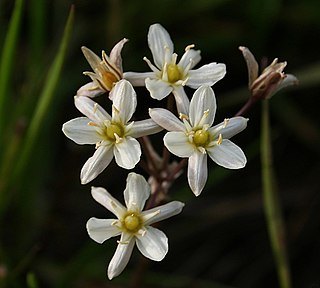
The genus Muilla includes four to five species of flowering plants.

Diplarrena is a genus of flowering plants in the family Iridaceae. The two species are endemic to Australia. The name is from Greek diploos ("double") and arren ("male"); plants in the genus have only two functional stamens, while all other Iridaceae have three. The name is often misspelled Diplarrhena, an error that began with George Bentham's Flora Australiensis in 1873.

Triteleia ixioides, known as prettyface or golden star, is a monocotyledon flowering plant in the genus Triteleia. It is native to northern and central California and southwestern Oregon, where it can be found in coastal and inland coniferous forests and other habitat. It is a perennial wildflower growing from a corm. It produces one to two basal leaves up to 50 centimeters long by 1.5 wide. The inflorescence arises on an erect stem up to 80 centimeters tall. It is an umbel-like cluster of several flowers each borne on a pedicel up to 7 centimeters long. The flowers are variable in size, measuring one to nearly three centimeters in length. They are pale to bright yellow, or sometimes purple-tinged white. There are six tepals with darker midveins in shades of green, brown, or purple. The lobes are funnel-shaped and may open flat or somewhat reflexed. The six stamens form a fused tube that protrudes from the corolla; they have broad, flat filaments and whitish, yellowish, or blue anthers.
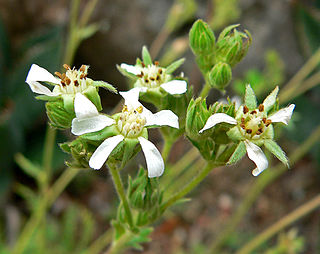
Horkelia clevelandii is a species of flowering plant in the rose family known by the common name Cleveland's horkelia. It is native to the Peninsular Ranges of southern California and northern Baja California. This is a perennial herb forming clumps of long, fernlike leaves and erect stems. The leaves are up to 18 centimeters long and are made up of triangular to rounded leaflets, each toothed or lobed and covered in thin hairs. The narrow stems reach 10 to 50 centimeters in height and bear inflorescences of several flowers. Each flower has hairy, lance-shaped bractlets and pointed sepals. The narrow oval petals are white. The center of the flower contains ten stamens and up to 50 pistils.
Malacothrix clevelandii is a species of flowering plant in the family Asteraceae known by the common name Cleveland's desertdandelion. It is native to parts of the southwestern United States and Baja California, where it can be found most often in chaparral, including cleared and disturbed areas such as slopes recently burned by wildfire. The plant is also found in southern South America where it is an introduced species. It is an annual herb producing a flowering stem up to about 35 centimeters in maximum height. The toothed leaves are largest at the base of the plant, and reduced farther up. The inflorescence is an array of flower heads each bearing rings of pale yellow ray florets roughly half a centimeter long.

Muilla maritima is a species of flowering plant known by the common names sea muilla and common muilla. It is native to California and Baja California, where it grows in many types of habitats from the coast to the Mojave Desert and Sierra Nevada foothills and other inland mountains, in grassland, woodland, desert, and forest floras. It is a perennial plant growing from a corm and producing an erect flowering stem up to half a meter tall. The onion-like leaves at the base of the stem may be 60 centimeters long. The flowering stem bears an umbel-shaped array of many flowers on pedicels up to 5 centimeters long. Each flower has six tepals which are green-tinged white in color with brownish midribs and no more than 6 millimeters in length. At the center of the flower are six erect stamens with blue, green, or purplish anthers.

Muilla transmontana is a species of flowering plant known by the common name Inland muilla. It is native to sections of the Great Basin in Nevada and in California east of the major mountain ranges. It grows in mountain forest and scrubby high desert and plateau habitat.

Oenanthe pimpinelloides is a species of flowering plant in the family Apiaceae known by the common name corky-fruited water-dropwort.
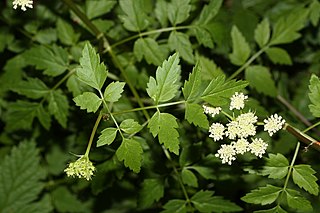
Oenanthe sarmentosa is a species of flowering plant in the family Apiaceae known by the common name water parsley. It is native to western North America from Alaska to California, where it grows in wet areas, such as streambanks. It is sometimes aquatic, growing in the water. The plant has been used in cultivation in wetlands, and the recent discovery of several colonies growing by a stream in Illinois demonstrates its capacity to become a noxious weed if it is introduced elsewhere. This is a perennial herb growing to a maximum height near 1.5 meters. The leaves have blades up to 30 centimeters long borne on petioles up to 35 centimeters in length. The parsley-like leaf blade is divided into serrated, lobed leaflets. The inflorescence is a compound umbel of many flowers with bright white to red-tinged petals.
Saussurea americana is a species of flowering plant in the aster family known by the common name American saw-wort. It is native to northwestern North America from Alaska to far northern California to Montana, where it grows in mountain habitat, such as meadows and forests. It is a perennial herb producing one or more hairy, glandular, erect stems up to a meter tall or more from a thick caudex. The lance-shaped leaves are up to 15 centimeters long and have toothed edges, especially the larger lower leaves. The inflorescence is a cluster of several flower heads, each a bullet-shaped body covered in purple or purple-tinged green phyllaries. The head opens at the tip to bloom with several white to purple tubular disc florets; there are no ray florets. The fruit is an achene tipped with a pappus, the whole unit sometimes exceeding a centimeter in length.
Sedum niveum is a species of flowering plant in the family Crassulaceae known by the common name Davidson's stonecrop. It is native to southern California and northern Baja California, where it is known from several local mountain ranges. It grows in rocky, forested habitat. It is a succulent plant forming basal mats of spoon-shaped or oval leaves no more than a centimeter long. The small inflorescence grows up to 9 centimeters tall and bears several flowers with white petals tinged or veined with pink. The stamens have red or black anthers.
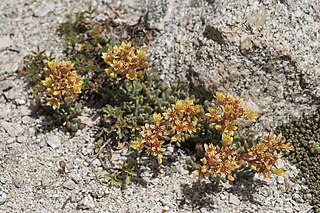
Sedum obtusatum is a species of flowering plant in the family Crassulaceae known by the common name Sierra stonecrop. It is native to the Sierra Nevada and adjacent high mountain ranges of California, its distribution extending north into Oregon and east into Nevada. It grows in rocky mountain habitat.
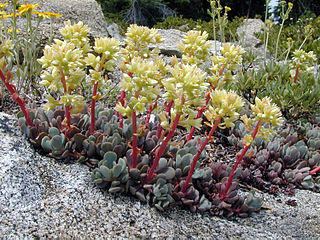
Sedum oregonense is a species of flowering plant in the family Crassulaceae known by the common name cream stonecrop. It is native to the Klamath Ranges of southern Oregon and northern California, where it grows in rocky habitat. It is a succulent plant forming basal rosettes of leaves up to about 4 centimeters long. Smaller leaves occur farther up the stem. The leaves are green in color and waxy in texture. The inflorescence is an erect, wide open array of many flowers. The flowers have yellow petals with red-tinged or white-speckled undersides.

Acleisanthes nevadensis is a species of flowering plant in the four o'clock family known by the common names desert moonpod and desert wing-fruit. It is native to a section of the southwestern United States encompassing southern Nevada and adjacent corners of Utah and Arizona. One occurrence has been observed in eastern California. The plant grows in desert habitat such as scrub and rocky washes. This herb produces several spreading stems up to about 30 centimeters in maximum length, sometimes from a woody base. The stems are covered in many leaves with fleshy oval or rounded blades up to 3 centimeters long which are borne on petioles. The herbage of the plant is coated in thick, wide, white, furry hairs, interspersed with shorter, flat hairs. Some hairs are glandular. Flowers occur in leaf axils. Each is a trumpet-shaped bloom with a narrow, tubular green throat up to 4 centimeters long and a round white corolla face about a centimeter wide, sometimes tinged yellow or greenish. There are five long, protruding stamens and a long style tipped with a spherical stigma. The fruit is a ribbed, hairy body with five broad, white wings.
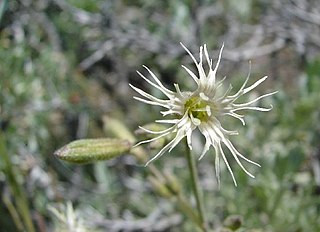
Silene oregana is a species of flowering plant in the family Caryophyllaceae known by the common names Oregon silene, Oregon campion and Oregon catchfly. It is native to the western United States, including the Great Basin, where it grows in habitat such as sagebrush and forests. It is a perennial herb growing from a woody caudex and taproot, sending up an erect, mostly unbranched stem which may be 70 centimeters tall. The lance-shaped leaves are up to 8 centimeters long around the caudex, and shorter farther up the stem. Flowers occur in a terminal cyme and sometimes in leaf axils. Each flower is encapsulated in a hairy, glandular calyx of fused sepals. The five petals are creamy white or pink-tinged in color and each has four to six long, fringelike lobes at the tip.

Triphysaria eriantha is a species of flowering plant in the family Orobanchaceae, known by the common names johnny-tuck and butter-and-eggs.

Triteleia hyacinthina is a species of flowering plant known by the common names white brodiaea, white tripletlily, hyacinth brodiaea, and fool's onion. It is native to western North America from British Columbia to Idaho to central California. Its habitat includes grassland and vernally moist areas such as meadows and vernal pools. It is a perennial herb growing from a corm. It produces two or three basal leaves up to 40 centimeters (16 in) long by 2 centimeters (0.79 in) wide. The inflorescence arises on an erect stem up to 60 centimeters (24 in) tall and bears an umbel-like cluster of many flowers. Each flower is a funnel-shaped bloom borne on a pedicel up to 5 centimeters (2.0 in) long. The flower is white, often tinged purple along the tubular throat, with six green-veined tepals. There are six stamens with white, yellow, or occasionally blue anthers.
Erythronium elegans is a rare species of flowering plant in the lily family known by the common names Coast Range fawnlily and elegant fawnlily. It is endemic to Oregon in the United States, where it is known from about 12 occurrences in the northern Coast Range.

Muilla lordsburgana is a species of flowering plant known by the common name Lordsburg noino. It is native to the eastern fringe of the Chihuahuan Desert of southwestern New Mexico, where it is found in scrub habitats atop Lordsburg Mesa. It is a perennial growing from a corm and reaching no more than 9 centimeters in height. The flowering stem bears an umbel-shaped array of up to 6, but usually fewer, flowers on pedicels up to 2 centimeters long. Each flower has six tepals which are white to pale lavender in color with a prominent green midvein. At the center of the flower are six stamens with wide white to pale lavender petal-like filaments. The filaments are partially fused into an erect, cylindrical "crown".
















